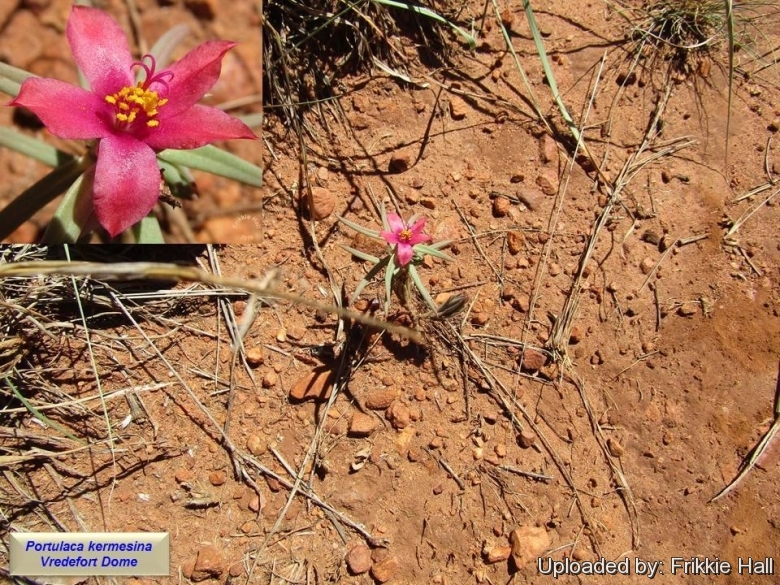




Your support is critical to our success.

Vredefort dome, Free State, South Africa.
Origin and Habitat: Sudan, Ethiopia, Eritrea, Tanzania, Uganda, Kenya, Congo, Namibia, South Africa, Botswana, Mozambique, Zimbabwe,
Type locality: Botswana, Kwebe Hills.
Altitude range: 0–1300 metres above sea level.
Habitat and ecology. Portulaca kermesinaSN|32887]]SN|32887]] grows on dry sandy soils in hot and dry areas, either in grasslands and in open woodland or at the margins of pans and seasonal swamps.
Synonyms:
- Portulaca kermesina N.E.Br.
Portulaca kermesina N.E.Br.
Kew Bull. 1909, 91 1909
Synonymy: 3
- Portulaca kermesina N.E.Br.
- Portulaca crocodilorum Poelln.
- Portulaca rubriflora Poelln.
AFRIKAANS (Afrikaans): Vygiebossie
Description: Portulaca kermesina, firstly described by Poellnitz in 1941, is a slender, erect annual herb or short-lived perennial, branching above the base with narrow, sharply acute, succulent leaves usually terminal. The flowers are bright carmine in colour terminal, often more than 5 together, opening towards mid-morning. They are encircled by long spreading involucral leaves, and the stamen number varying from 10–25. The seed is metallic-grey or silvery. This species of the purslane family presents several morphological or local forms.
Derivation of specific name: 'kermesina' (Latin), carmine.
Stems: 8-15(–28) cm high, segmented, sub-woody, largely leafless, rather stiffly ascending, branching mainly near base.
Leaves: Simple, alternate, spaced, usually terminal, linear-terete, (4-)9–12(-25) mm long, (0.6)1–1.4(-2) mm wide, tip acute. Axillary hairs conspicuous brown to whitish in long shaggy tufts, more or less persistent up to 5–8(–10) mm long, sometimes indistinct, each axil (outside flora area) also with 2 longer, brownish, hair-like scales with falcately-curving bases (these sometimes indistinct).
Flowers; In terminal clusters of 3–6 or more, encircled by about 8 involucral leaves enclosing a dense mass of brownish hairs, opening in the morning. Involucral leaves (leaf-like bracts) longer than the stems leaves, very variable in length, 9-30 mm long, slightly to much exceeding the flower cluster, spreading, finally slightly downturned. Sepals 3–5 mm long, fleshy, rounded on the back, keeled towards the acute apex with a slight crest. Petals 5, shorter than involucre,, usually bright red, occasionally orange-red, rose-pink, purplish-red, or rarely yellow, 2.5–8 mm long, obovate-oblong, tip obtuse to acute. Stamens (5–)8–15(–25). Stigma (3–)4–5-lobed .
Fruits (capsules): 5 mm long, 2.5–3.5 mm in in diameter, dehiscing below the middle, lid a conical or rounded dome about as wide as high c. 2.5 mm high, glossy straw yellow, fragile.
Seeds: 0.5–0.75 mm long, metallic grey or occasionally silvery or brightly iridescent.
Similar species: P. kermesina is a very widespread species and local variants are commonplace. P. kermesina has often been confused with the similar Portulaca foliosa but its stems are always erect or suberect, the stipular hairs usually are more persistent, more numerous and up to 7 mm long. Moreover the yellow-flowered P. foliosa has retuse petals and black seeds. These two names have also been widely misapplied to other species in the area. Portulaca crocodilorum it is probably not distinct from P. kermesina as it appears from the description to differ only in having blunter petals. This species is possibly conspecific with Portulaca anceps, known only from the type from Ethiopia. P. anceps supposedly differs by the “purple” flowers and fewer involucral leaves, but these could well prove not to be real differences. Portulaca fischeri is also closely related. The difference is very slight and it could well be that P. fischeri will have to include P. kermesina. Specimens from coastal sand south of the Tana River (Kenya) approach Portulaca coralloides in their slender habit and high stamen number.
Bibliography: Major references and further lectures
1) H. Wild “Flora Zambesiaca” FZ, Vol 1, Part 2, page 362, 1961
2) Sylvia M. Phillips “Flora of Tropical East Africa” 2002
3) M. G. Gilbert “Flora Somalia” 1993 [updated by M. Thulin 2008]
4) Doreen Court “Succulent Flora of Southern Africa” CRC Press, 01 June 2000
5) David Hardy, Anita Fabian, Gerrit Germishuizen “Succulents of the Transvaal” Southern Book Publishers, 1992
6) Gerrit Germishuizen “Transvaal Wild Flowers” Macmillan South Africa (Publishers), 1982
7) Ib Friis, Olof Ryding “Biodiversity Research in the Horn of Africa Region: Proceedings of the Third International Symposium on the Flora of Ethiopia and Eritrea at the Carlsberg Academy, Copenhagen, August 25-27, 1999” Kgl. Danske Videnskabernes Selskab, 2001
8) Gideon Smith, Neil R. Crouch “Guide to Succulents of Southern Africa” Struik Nature, 2009
9) Foden, W. & Potter, L. 2005. Portulaca kermesina N.E.Br. National Assessment: Red List of South African Plants version 2015.1. Accessed on 2016/04/26
| Your Actions | |
|---|---|
| Back to Portulaca index | |
| Back to Portulacaceae index | |
 |
Back to Succulents Encyclopedia index |
Privacy stantement - Terms and conditions - How to cite - About us - Feedback - Donate




